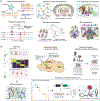What is a cell type and how to define it?
- PMID: 35868277
- PMCID: PMC9342916
- DOI: 10.1016/j.cell.2022.06.031
What is a cell type and how to define it?
Abstract
Cell types are the basic functional units of an organism. Cell types exhibit diverse phenotypic properties at multiple levels, making them challenging to define, categorize, and understand. This review provides an overview of the basic principles of cell types rooted in evolution and development and discusses approaches to characterize and classify cell types and investigate how they contribute to the organism's function, using the mammalian brain as a primary example. I propose a roadmap toward a conceptual framework and knowledge base of cell types that will enable a deeper understanding of the dynamic changes of cellular function under healthy and diseased conditions.
Copyright © 2022 Elsevier Inc. All rights reserved.
Conflict of interest statement
Declaration of interests The author declares no competing interests.
Figures




References
-
- Abbott LF, Bock DD, Callaway EM, Denk W, Dulac C, Fairhall AL, Fiete I, Harris KM, Helmstaedter M, Jain V, et al. (2020). The Mind of a Mouse. Cell 182, 1372–1376. - PubMed
-
- Agathocleous M, and Harris WA (2009). From progenitors to differentiated cells in the vertebrate retina. Annu Rev Cell Dev Biol 25, 45–69. - PubMed
-
- Arendt D (2008). The evolution of cell types in animals: emerging principles from molecular studies. Nature reviews Genetics 9, 868–882. - PubMed
Publication types
MeSH terms
Grants and funding
LinkOut - more resources
Full Text Sources
Other Literature Sources

